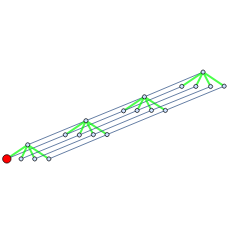Graph Products
Graph Products
In general, a graph product of two graphs G and H is a graph with vertex set and edges given by a function of the edges of and . We present the four most canonical such products:
V(G)×V(H)
G
H
G□H={(,)~(,)|(=∧~)∨(~∧=)}
u
1
u
2
v
1
v
2
u
1
u
2
v
1
v
2
u
1
u
2
v
1
v
2
G×H={(,)~(,)|(~)∧(~)}
u
1
u
2
v
1
v
2
u
1
u
2
v
1
v
2
G☒H=(G□H)⋃(G×H)
G○H={(,)~(,)|(~)∨(=∧~)}
u
1
u
2
v
1
v
2
u
1
u
2
u
1
u
2
v
1
v
2
Except the lexicographic, they are all commutative. It is natural to display such graphs on a grid, however, this can obscure adjacency by overlapping edges. To reveal the graph structure we offer three options: perturb the vertex positions with random noise, use the sliders to specify a function distorting the grid coordinates, or curve the edges. Alternatively, one can view the operation as an equation. For the cartesian product there is a special, additional embedding (and edge coloring) designed to highlight the subgraphs corresponding to the factors and an angle parameter that can adjust their relative orientation (the vertices can also be perturbed). Moving the mouse over the vertices of any graph in equation form will reveal the projections of the selected vertex.



